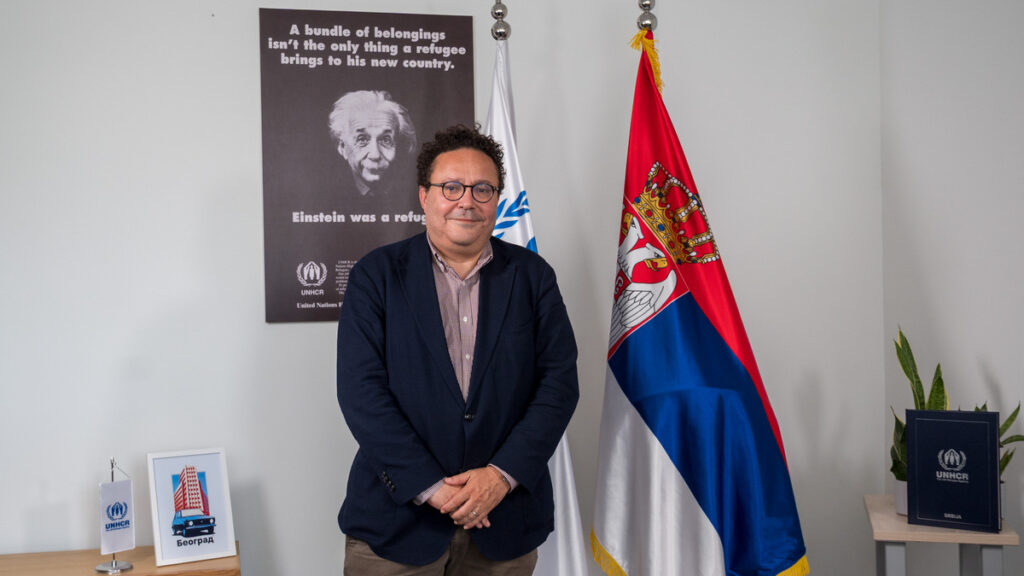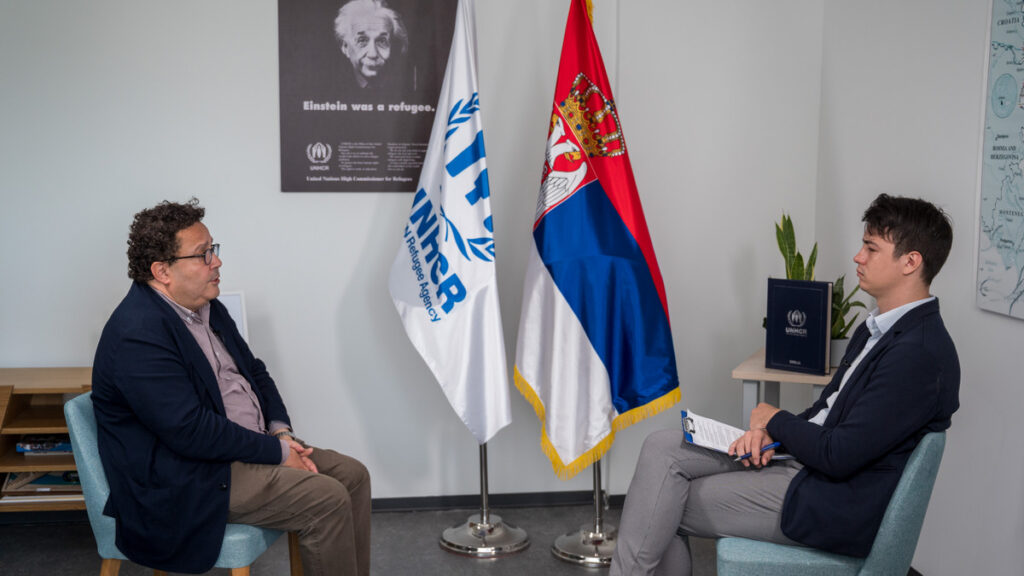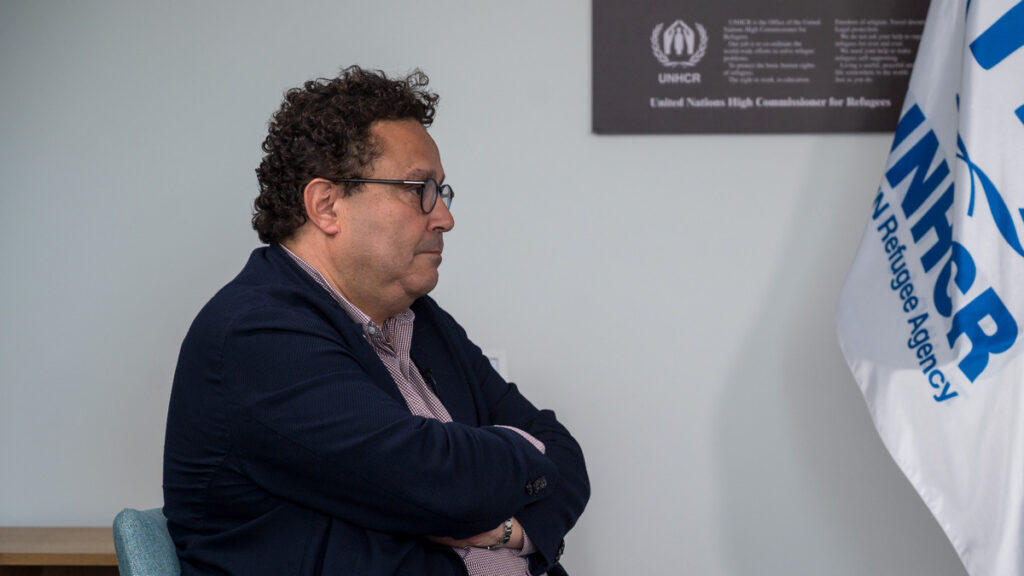On refugee integration, cooperation with the state, and the challenges of humanitarian protection in a rapidly changing world

In this interview for Diplomacy&Commerce, conducted in cooperation with Euronews Serbia, we speak with the UNHCR Representative in Serbia, Soufiane Adjali, about the organisation’s work, current challenges, and its role in supporting refugees and displaced persons in the country.
Could you share with us what your key priorities have been ever since taking office?
I arrived in a country where UNHCR has been present since 1976. One of the objectives is to look at windows of opportunity available to enhance the protection of people in need of safety and dignity. This entails ensuring they have legal rights, are included in society, and contribute to it by working rather than being a burden.
We also worked on another subject, statelessness, to make sure that all people born in Serbia of Serbian origin are documented and not at risk of being stateless. These priorities are very important to me. Next year, we will be celebrating half a century of UNHCR’s presence in Serbia.

You’ve worked in America, the Middle East, Africa, and Europe. How have the challenges refugees face varied across these regions?
The 1951 Convention, which we’ll celebrate next year on its 75th anniversary, has a consistent purpose: life-saving protection across all parts of the world. It has provided safety to millions. We often forget that the people under our mandate are not fleeing for economic reasons; they are seeking security, safety, and the hope of one day returning home in dignity.
For viewers unfamiliar with UNHCR’s work, could you explain how the organisation helps refugees in Serbia integrate into society, including access to employment and education?
First, I’d like to thank the people of Serbia for hosting, for many years, individuals escaping persecution and war. We’re here to help the government and the people understand that those crossing into Serbia, families, young men, are often escaping to protect their loved ones who are refugees elsewhere.
They shouldn’t be seen only as individuals on the move. Conflicts last for years, not just one, and options are limited. These people are rich in experience. They come with educational backgrounds and career plans.
UNHCR Serbia is trying to explore innovative and individualised approaches to inclusion and integration, taking into consideration refugees’ specific situation and needs, but also their unique skills and talents.
Also, UNHCR has been implementing the DAFI (Albert Einstein German Academic Refugee Initiative) scholarship programme in Serbia since 2021, enabling the first refugees here to access public tertiary education. UNHCR is proud of the six university students who are currently studying in Serbian successfully.
Income taxes matter. We don’t want refugees to work in the shadow economy; we want them employed with proper contracts. Thanks again to the Members of Parliament who adopted a law allowing foreigners to access the labour market after six months of seeking asylum and protection. This enables them to contribute rather than receive assistance.
For many refugees, Serbia is a transit country en route to the EU. What challenges does this pose for humanitarian efforts?

Movements are mixed. Some people can return home, but UNHCR focuses on those who cannot. Often, they fall into the hands of criminals who promise safety. People are misled and unfamiliar with Serbia.
Yet, Serbia holds significant potential to be more than just a transit point – it can also be a country of asylum. The solidarity demonstrated by its citizens during the 1990s, when many opened their doors to refugees from the region, and again during the 2015 European Refugee Crisis, speaks volumes about the country’s humanitarian spirit. By continuing to strengthen its asylum system and investing in local integration pathways, Serbia can serve as a model for responsible and humane refugee response in the region.
The latest UNHCR analysis states that over 122.1 million people are forcibly displaced worldwide, a number that has doubled in the last decade. What are the main drivers behind this increase?
We’re now speaking of 123 million forcibly displaced persons. Among them, 9 million have returned home, 8 million are internally displaced persons who returned to their houses, and 1 million refugees have returned in safety and dignity. We keep them in our statistics because we monitor their reintegration.
The trigger is the weakening of multilateralism. The UN Security Council is a tool for peace, and we rely on it to help countries become more peaceful so people don’t have to flee their homes. UNHCR’s caseload shows that 77% of displaced people come from the Southern Hemisphere, far from the Northern Hemisphere, where they seek protection.

While displacement numbers have doubled, UNHCR’s funding remains at 2015 levels. How does this affect refugee assistance programs?
While the number of forcibly displaced people has almost doubled from 64.1 million in 2015, UNHCR’s resources are now more or less at the same level as a decade ago. In 2015 UNHCR was funded to the tune of $3.4bn – almost the same level we expect to be funded for 2025. This situation is not sustainable. The funding crisis has put the humanitarian system at breaking point.
It’s impossible to predict the impact of the brutal humanitarian funding cuts on displacement figures. The impact on refugees’ lives is already devastating. With aid slashed, millions of lives are now at risk. This impact is immediate and severe: critical medicines, emergency shelter, food, relief items, clean water and protection services, including to children and survivors of sexual violence and trafficking have already been severely reduced or stopped. Wars continue to force thousands to flee their homes to save their lives. In the absence of stability or peace, these funding cuts mean those in danger will not receive assistance, and more lives will be lost. Slashing aid will make the world less safe, driving more desperate people to become refugees or keep moving onwards.
In the same report, it is said that 60% of forcibly displaced people are internally displaced, meaning they never even leave their own home country. What are the obstacles in finding solutions for internally displaced persons?
For internally displaced persons, the key point is that they haven’t crossed the international border of their country. UNHCR refers not only to those displaced by natural disasters, but also to those affected by instability and political discomfort.
When people move within their own country, they seek areas where they feel safe. If a country has functioning institutions and stability, and if people feel their human rights and the rule of law will be respected, they are more likely to return. Unfortunately, many of these conflicts, especially in the Southern Hemisphere, keep people displaced within their borders, waiting for the moment they can safely return home.
An important aspect of this issue is media coverage. UNHCR has organised a workshop with the Journalistic Association of Serbia on responsible coverage of refugee-related topics. To what degree does this affect the perception of refugee integration in society?
Journalism plays a key role. Journalists must be respected and protected. It saddens me when I hear of journalists dying on the front lines to provide us with information.
It’s important to sit with journalists because they shape public understanding. They provide factual pictures that help people form their own opinions. Journalism is about freedom of expression. Journalists doing their job will understand the definitions of migrant, refugee, and asylum seeker and won’t speculate.
These workshops, that we’ve been organizing for three years now, provide a unique opportunity to exchange ideas and work together to create a more positive narrative about people forced to flee – always based on relevant data and evidence.
There is hope when we train journalists to use accurate language and understand that fear of the unknown can lead to harmful stereotypes. There are criminals in every society, but foreigners are often unfairly blamed for instability.
There’s a stereotype, yes.
I believe that strong state institutions create security. If we all do our jobs, safety is possible. If we criticise, it means we’ve failed.
Everyone is responsible for ensuring safety for both foreigners and host communities. If the host communities don’t feel safe, how can they welcome others? These trainings help, not dictate, but offer a vision. Journalists have their freedom, and we respect it.
We’ve also mentioned the importance of employment for refugee integration. UNHCR has launched a career guidance manual. Could you tell us about it and its impact on helping refugees find employment opportunities?
Before launching the guide, we created a network connecting refugees with the private sector. We worked with different partners, including the Serbian Chamber of Commerce, as well as Chambers of Commerce from different countries present in Serbia.
We established a network to help asylum seekers who choose to stay in Serbia integrate into the labour market. This doesn’t happen overnight. We worked with the National Employment Service, the Commissioner for Refugees, and the Ministry of Interior to facilitate integration.
We’re now improving refugee documentation so they can open bank accounts and receive proper wages. Some have even started private businesses and become independent entrepreneurs. We’re developing tools to support this, but it won’t succeed without support from the government and the people of Serbia.
So you need this collaboration for it to happen.
Exactly. I’m not in my own country; it’s the host country’s decision. And in Serbia, we often receive positive feedback.
That’s great to hear. You mentioned collaboration with the private sector, which has been a fruitful partnership with UNHCR. Could you elaborate on how this works in practice?
UNHCR’s collaboration with the private sector in Serbia has been critical in advancing the inclusion and empowerment of refugees. A key highlight of this partnership is the #ForRefugees network, launched jointly with IKEA, one of UNHCR’s longstanding and trusted global partners. This network brings together representatives from domestic and international companies, as well as chambers of commerce, creating a dynamic platform for dialogue, collaboration and action.
Through this initiative and other partnerships, the private sector has provided indispensable support in several critical areas, including refugee employment, career guidance and access to training opportunities. These efforts not only help refugees rebuild their lives with dignity but also contribute to more inclusive and resilient communities.
Looking ahead, it is essential to further explore and expand cooperation with the private sector. Their innovation, resources and reach are vital in creating sustainable solutions for refugee inclusion and in fostering a society where everyone can thrive. UNHCR isn’t dealing with huge numbers. We’re talking about approximately 259 refugees in Serbia and around 1,000 under temporary protection.
But it’s still impressive nonetheless. We’ve also mentioned the issue of statelessness. What has UNHCR achieved in Serbia regarding this, and would you say it’s being reduced or eradicted?
Serbia has done very well. Thanks to legislative reforms, capacity-building of state officials, and dedicated work with vulnerable communities – primarily Roma and internally displaced persons, Serbia has managed to reduce the estimated number of people at risk from several tens of thousands in 2010 to approximately 1,300 today. Of these, around 200 to 250 individuals still remain unregistered in the civil registry.
Ministry of Public Administration and Local Self-Government and other partners are working on ensuring that all children are registered in the civil registry immediately after birth—even in cases where the mother lacks personal documents or is herself unregistered. To close this gap additional legal changes are needed.
Serbia is on the right path and doing better than many countries in the region. We’ll continue working and hope to see free legal aid become more accessible for those at risk.
Very important. You’ve also worked with local youth. Could you share your impressions? Are you successful in helping them navigate the narratives surrounding refugees?
We’ve been working with youth and will continue to do so. They are the future. I hope we’re building a world of peace, hope, and opportunity for them.
And the youth, when they grow up, can learn many languages, and they don’t distinguish between them. It’s what we put in their minds that shapes and formats them. I believe their genuineness and innocence don’t make them any less clever than others.
They can absorb a lot. We often say this about babies, but it applies to youth as well; they are the power of the future. They are the ones who will lead us. When we grow old, they will be the ones managing us. And we want them to manage us well.
So we need to prepare them well for the future.
You mentioned the future. Could you tell us what your hopes are for the future regarding these issues and global challenges surrounding refugees?
The good thing is, we want peace. My hope is for peace.
And this is the basis?
The basis of everything. We can talk about many things, but without peace, there is no hope. That’s the number one priority.
We need to improve the international mechanisms established after the Second World War to function more effectively. We often envision a bleak future.
But I think we must be optimistic. We need to realise that we all live on the same planet and we are all responsible for each other. I think that is my key message.